#enterprise was early 2000s
Explore tagged Tumblr posts
Text
dr Phlox talking about his poly marriages and children so cool, good to hear his wives and their husbands have each other while he's away
#very funny how they managed to create such a complicated polycule and still keep is somewhat streight#but thats early 2000's for you#still in my headcanon Denobulan relationships are mostly queer in our current use of the word#dr phlox#star trek enterprise
22 notes
·
View notes
Text
#awww poor trip always has the alien ladies making advances and impregnating him#enterprise#star trek (@impossiblepluto)
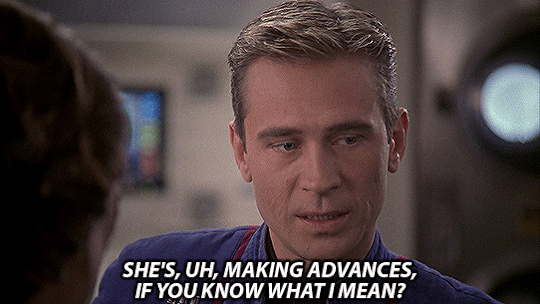

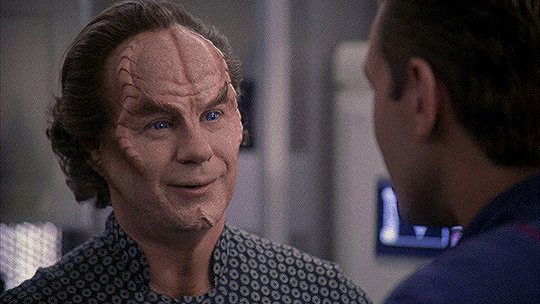
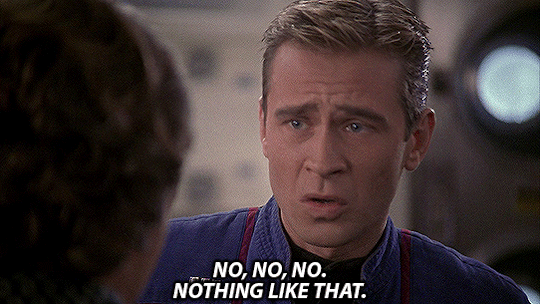



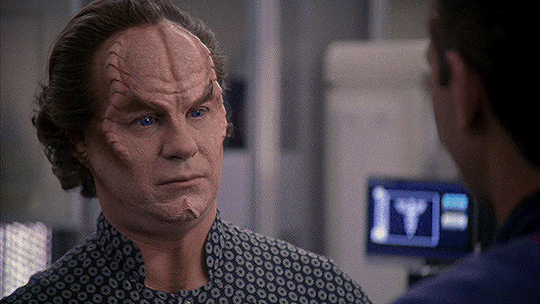
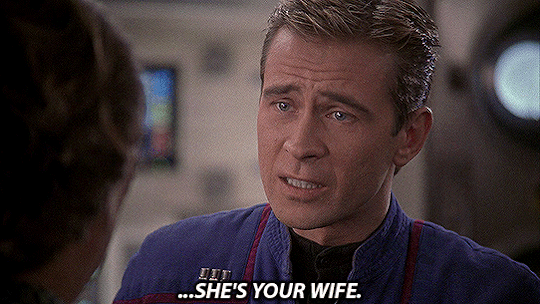

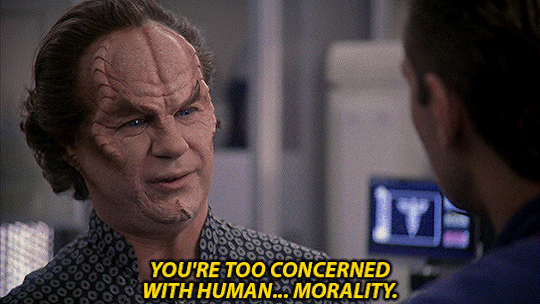

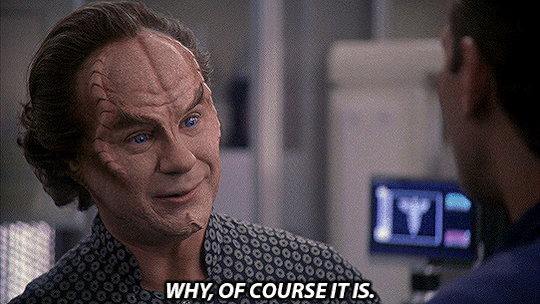
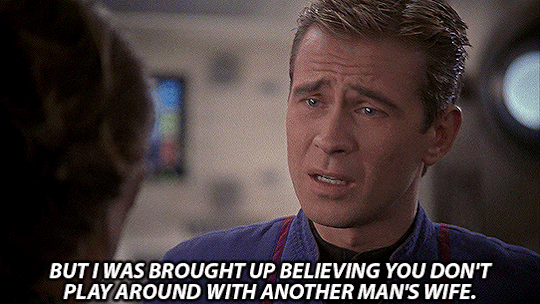



Star Trek: Enterprise // S02E14: Stigma
#lmao#you can't leave that in the tags#I DIE#Star Trek Enterprise starts off season 1 with MPREG and this was like the early 2000s#I CAN"T#Also the best title sequence ever#come at me bro
13K notes
·
View notes
Text
I love how shocked people's reactions are any time I casually mention the kind of egregious bullshit that was business as usual in tabletop RPG publishing in the 1990s/early 2000s. Like, we're talking about the kind of folks who would willingly publish niche elfgames before the advent of easy digital distribution. You were maybe expecting well managed enterprises headed by well adjusted people?
570 notes
·
View notes
Text
"The Ayla Descent Theory" of Mary Sues
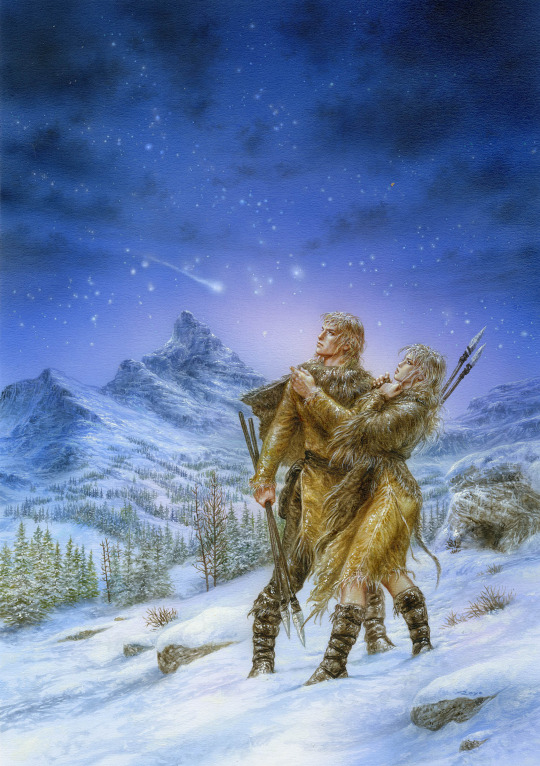
"Children of the Earth," Luis Royo.
After the success of Jean M. Auel's stone age novel Clan of the Cave Bear, there was a very lengthy trend in the publishing world of stone age adventure novels aimed at women that lasted for a decade and only really fizzled out in the early 2000s. After all, "Ayla," the name of the main character of these books, was one of the top baby names of 1987.
The target audience for these books were weird midwestern aunts....you know, the Mists of Avalon and the Mercedes Lackey/Valdemar audience. Therefore, the Clan of the Cave Bear imitators also featured things of interest to the weird aunt audience: Scotland, redhaired women with sharp tongues, commanding wolves, Ireland, Feminism, riding herds of wild horses bareback in scenic locations, Wicca, matriarchial religions, swimming with dolphins....but above all else, American Indians (a culture this audience finds interesting, as anyone who has seen the home decor of a typical weird midwestern aunt can attest), with many novels set in Ice Age America, like Children of the Dawn, Reindeer Moon and the First Americans. Decades later, this audience would form the core fandom for Game of Thrones, and the character of Khaleesi Targaryen in particular.

These books almost assuredly still have a place of honor on the book shelf of the weirdest woman at your job.
Nearly all of these imitators have two of Clan of the Cave Bear's defining traits: 1) a supremely beautiful, usually blonde athletic and statuesque main character over 5'11" who does not realize that she is so beautiful and desirable, who is good at a variety of different skills and is friendly with animals like hawks, dolphins, or horses, and 2) a love triangle between this aforementioned blond but innocent Venus and two bodybuilder muscular he-men cave hunks, one of whom is a blonde guy with long rock star hair (it was the 80s), and the other being a buff black guy with dreadlocks (or otherwise ethnic in some way).
The heroine usually picks the blonde guy in the end, but the audience usually picks the ethnic guy.
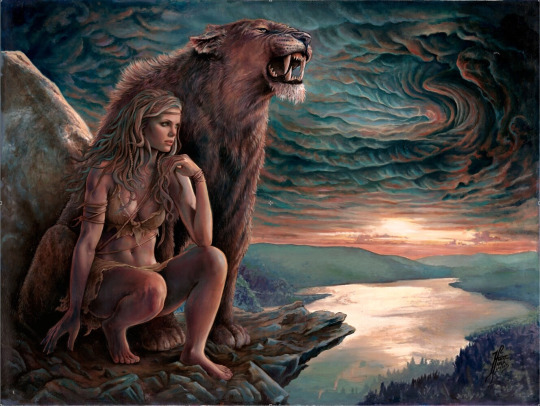
In the late 90s and early 2000s, in the broader culture of fandom, it was fashionable to dump on "Mary Sues" (indulgent wish-fulfillment author personas in fanfiction) and the people who wrote them. Accusations of creating a Mary Sue approached a kind of hysteria. Even at the time, when everyone else was getting swept up in this, I thought that getting mad about aunties writing fanfiction showed a loss of perspective, and was a bit silly. Thankfully, we've benefitted from moral evolution: the consensus in fandom now is that writing aspirational characters is a harmless activity that tests a young writer's creative muscles, like the half-Vulcan pretty new ensign on the Enterprise that Kirk and Spock both fall in love with, or a new archer girl who Legolas falls in love with joining the Fellowship. This hate walked hand in hand with insecurities, in the exact same way that people worried about their appearance or concerned with their weight are often cruel to fat people, and there were frequent tests if this or that character in your writing was a Mary Sue.

There was a running joke in this 2000s culture of anti-self insertion called the "Ayla Descent Theory of Mary Sues." The joke was that Mary Sues came into existence because Ayla, the beautiful, athletic heroine of the Clan of the Cave Bear novels, was the ancestor of their entire lineage, as the first known Mary Sue to ever exist in the historical record, described as being a statuesque blonde who did everything right and was always at the center of love triangles, and who changed human history.
According to the running joke, Mary Sues everywhere were descended from Ayla from Clan of the Cave Bear, and she was the first to exist, and Ayla was the explanation of where all the Enterprise's new ensigns main characters fall in love with come from.
520 notes
·
View notes
Text
People responding in the tags with "but it's all gay!" clearly you've never seen an episode of Enterprise
Younger sister: I want to watch Star Trek, where should I start?
Me: Well that depends on what's most important to you. Do you want to watch a show that's good, a show that makes sense, or a show that's gay?
Younger sister: Oh, definitely gay
Our mom, who was not at all involved in the rest of the conversation, yelling from the kitchen: You better start with the original series then!
#even their mpreg was straight#like come on#I don't think Enterprise is as bad as people make it out to be#but its chalk full of early 2000s heterosexuality
288 notes
·
View notes
Text
So I’ve been thinking about Bruce, Clark, superbat, and queerness and how sexuality would have interacted with their various identities depending on the time period.
(cw: discussions of homophobia)
These days, I’ve seen a lot of fics where Brucie Wayne has always styled himself as a bisexual disaster and leaned into that aspect of his identity to sell the brucie wayne persona and sometimes it’s super fun! I love that for him! But I’m in the process of writing a fic where superbat have a summer romance in their late teens/early 20s pre-capes and then meet up years later and there’s angst and one-sided identity shenanigans as bruce realises that Superman is the One That Got Away, etc, (and also how much the way he left clark back then fucked clark up real good).
So I was doing the maths to figure out when that actually would have been, using that Tim Drake Robin comic run that was set in 2007 as a baseline and combining that with basic info/generally accepted facts/fanon on how far apart the bat kids are in age etc. And I worked out that Bruce was probably born (in that continuity) around 1967 I assumed that Clark was maybe slightly younger for the sake of the fic so lets say he’s born in 1969 (also. I think it would be funny for clark to be the same age as the Moon Landing). Which means superbat would have both grown up and started figuring out sexuality stuff in the eighties.
Even if you set aside how traumatic it was to be a queer person in that time period, that means that Dick would have been orphaned in 1993 or ‘94 (give or take) and Jason would have come along in approximately 2002. Idc how rich he is, a single, openly queer man would not have been given custody of children in the 90s or 00s. For such a high-profile openly queer man, even trying would have been a disaster - not only potentially for Bruce and Dick as individuals, but for Wayne Enterprises (and Batman, indirectly) by association.
And even if Bruce and Clark are in their early forties in 2025, that still means they would have been coming of age in the early 00s. Basically, if we wanna be historically accurate about it (and totally chill if you don’t! I also enjoy escapism sometimes!) Brucie Wayne had way too much to lose (mostly his kids) to be openly Bi for most of his life. Maybe if he’d never adopted Dick as his ward or Jason as his sons it wouldn’t matter so much.
Idk as a queer who remembers how homophobic things were in the 2000s, I’m compelled by the idea of this being another thing Bruce has to sacrifice for his family and his mission, another point of difference between the man and the Brucie Wayne persona.
#I’m certain this has been said before but I haven’t seen it since I joined the fandom and its not really featured in fics I’ve read#so I’m just wondering what other fandom folks think about this#dc#batman#superbat#bruce wayne
75 notes
·
View notes
Text
Doyleistic History of the Vulcan Language
I prefer to talk about the Vulcan language in-universe, to come up with history and possible reconstructions. But in my search for meanings and explanations, I keep smashing my face into the real-life history of all the kinds of Vulcan that have been invented. That especially becomes a problem when I try to apply what I know about Vulcan to the canonical uses of the language.
So, after my last post on Vulcan, I decided to take a minute to talk about where Vulcan comes from, and what it means when I say I study Vulcan.
The first words of any type of Vulcan were invented for TOS, mostly by Theodore Sturgeon for Amok Time. (Not all of them were used in the final episode.) This is where we get pon farr, plak tow, kalifee, and kroykah. I don't think any subsequent version of Vulcan has failed to include these key words.
By 1968 we had the first beginnings of a fanmade conlang, by Dorothy Jones Heydt, published in Spocknalia volume 3. This version has no relation to any subsequent versions I know of, but her word "ni var" (two form, two aspects of the same thing) ended up being canonized later.
None of this was used for Vulcan's next appearance, which was in Star Trek: The Motion Picture. The scene at Gol was filmed in English, but after filming, it was decided that it didn't seem right and they wanted to dub it over in Vulcan. Thus the words invented for the scene were made to fit the mouth movements already on film. Jimmy Doohan allegedly did most of this. So the phrase thrahp, hif-bi tu throks, is specifically made to fit something like "Spock, give me your thoughts."
The next two movies use a Vulcan that was allegedly made by Marc Okrand, though I can't for the life of me find out how much Vulcan he made up to make these sentences or how he meant the grammar to work. This is where we get words like ish-veh, he/she/it, and dungi, will. But other words, such as ikh-banut or wakli, aren't parsed anywhere that I know of.
A few words were made up by novel writers. Diane Duane, for instance, invented the words cthia (reality-truth), T'Khasi (Vulcan) and T'Khut (Vulcan's sister planet).
The language most fans use, however, is from none of these sources. What is called "Vulcan," or more properly Vuhlkansu or Modern Golic Vulcan, is the creation of a fan named Mark Gardner, along with several other people. The work began in the 70s and continued till the early 2000s. There's a book and an archived website. The sources also go with the Vulcan Language Dictionary available online.
It has the advantage over all the other sources that it is actually made as a (mostly) complete and usable language. It's something of a hodgepodge, however. The base of the language was reverse-engineered from the small quantities of Vulcan used in the first three movies. The problem with this is obvious: the Vulcan used in the first three movies was not created as a consistent language. Choices had to be made. I should probably make another post about the choices I would have made, but suffice it to say, these sources are different enough from Golic Vulcan that analyzing them might well produce something entirely different. And yet one gets the impression that they are the same language because some of the words are the same. You think you might be able to understand them using the VLD--but for the most part, you can't.
Gardner's dictionary also includes words from beta canon and a few words from fanfic. The rest was invented one word at a time, based on rules the creators had set down about phonetics and root words.
So, after that, did subsequent Star Trek use any of what Gardner had created?
No. It did not. I wish it had, despite the flaws, because I always prefer understandable conlangs in shows and Paramount seems to have no intention of making their own. Conlangs can't be copyrighted; that's presumably why they felt okay picking up words like "ni var" from fans.
The Vulcan in Enterprise was allegedly also made by Marc Okrand. (Memory Alpha gives us a big fat Citation Needed for this. I can find no other source.) However, looking at the (scanty) text used in both, I don't really see any similarities. For instance, ish-veh for he/she/it does not appear, though one would think it should, and I can't pick out any grammatical structure at all. (You can try it yourself with the very small corpus at Memory Alpha. I plan to dive deeper into these texts in a future post.)
Did Marc Okrand make this? As a real linguist, if he did, I'd like to think he'd bother to make something other than simply noises, but without either more text or more translations, it's difficult to be sure. I can't tell that it isn't gibberish like TMP, in other words.
Discovery and Strange New Worlds also use "Vulcan" and I can't parse those either according to Gardner's Vulcan or according to what little exists in the corpus. This is, of course, devastating to me. What's the point of a conlang if you can study everything that exists and you still can't understand what they say on the show?
I would like to believe that STII, STIII, Enterprise, Discovery, and SNW are all using some lean but grammatically consistent conlang created by Marc Okrand, which, as more text is released, we may finally come to understand a little. However, I can find no evidence of this. There is no Vulcan language consultant credited on SNW or Discovery, although there is a Klingon consultant. Could they be altering Klingon to fit it in? Could the Klingon consultant be making up a quick Vulcan conlang on the fly? Could they have access to Okrand's secret Vulcan notebook? Hours of research have turned up nothing.
I talked to someone at a convention last year who said she had been at a talk given by Marc Okrand where someone asked about Vulcan. She said he only shook his head and said it was a mess.
SECONDED, DOCTOR OKRAND.
Anyway, that's why we're out here using the VLD, despite its obvious flaws. For better or worse, it's the only usable Vulcan there is. But the fact that it doesn't match the Vulcan from any canon but the first three movies, and that only because it was derived from them in reverse, is kinda depressing, I'll admit.
If you have any further information about the real-life history of Vulcan conlangs, please let me know!
54 notes
·
View notes
Note
Hi, I just saw your post criticizing people calling Dick “a whore,” and I agree with it all; expect “Tim and Bruce are the family whores.” I just wanted to point out that I think it’s equally wrong to call Tim a whore because of the amount of times that boy has been sexually assaulted and/or harassed. If you criticize people calling Dick a whore, I personally think it’s in equal bad taste to call Tim one.
I see where you’re coming from but Tim Drake is a serial monogamist with a hole dam roster of love interests. He has had two love interests at the same time, balancing relationships both as Red Robin and as Tim Drake.
After abit of digging to refresh my memory, here’s an expanded, detailed breakdown of his confirmed romantic relationships, including what runs they were from and whether they were fully developed or just implied crushes/flings.
Tim Drake’s Canonical & Consensual Relationships (Confirmed Roster)
1. Stephanie Brown (Spoiler/Batgirl) – The OTP
• First Appearance: Detective Comics #647 (1992)
• Main Relationship: Robin (1993) #16–#183, Batgirl (2009), Red Robin (2009)
• Status: Longest and most iconic love interest
• Notes: This was Tim’s longest relationship, though very on-off-again. They had multiple breakups, but DC consistently revisited them. Strong emotional connection, and one of the few love interests who truly understood Tim.
2. Ariana Dzerchenko – His First Girlfriend
• First Appearance: Robin (1993) #1
• Main Relationship: Robin (1993) #1–#74
• Status: Official girlfriend before Stephanie
• Notes: she was his first real gf and the relationship was actually pretty stable, they broke up bc she thought he was cheating
3. Zoanne Wilkins – High School Girlfriend
• First Appearance: Robin (1993) #148
• Main Relationship: Robin (1993) #148–#183
• Status: Civilian love interest
• Notes: very similar to his relationship with Ariana
4. Tam Fox – Love Interest in Red Robin Era
• First Appearance: Batman: The Dark Knight #1 (2011)
• Main Relationship: Red Robin (2009) #1–#26
• Status: Strong romantic subplot
• Notes: Daughter of Lucius Fox, and Tim’s love interest while he was leading Wayne Enterprises. Very close to becoming serious, but Tim’s mission got in the way.
5. Cassie Sandsmark (Wonder Girl) – Grief-Driven Romance
• First Appearance: Wonder Woman (1996) #105
• Main Relationship: Teen Titans (2003) #92–#100
• Status: Brief, grief-fueled relationship
• Notes:
Happened after Superboy died and it was more about coping with loss than real romance. Ended quickly once they realized it was unhealthy.
6. Bernard Dowd – Current Canon Boyfriend
• First Appearance: Robin (2004) #121
• Main Relationship: Batman: Urban Legends (2021)
• Status: Tim’s first confirmed same-sex relationship
• Notes:
Bernard originally appeared in the early 2000s but was reintroduced in 2021. Their relationship officially confirmed Tim as bisexual.
Lesser-Known or Minor Romantic Connections
These relationships weren’t as major but still counted as actual romantic interests.
7. Darla Aquista – Briefly Dated, Became a Villain
• First Appearance: Robin (2004) #121
• Status: Brief romance, turned into a villain
• Notes:
She was introduced as a civilian love interest. Later became the magic-powered villain Vittoria under Penguin’s gang.
8. Dana (Last Name Unknown) – Minor Love Interest
• First Appearance: Robin (1993) (exact issue unclear)
• Status: Barely developed romance
• Notes:
She existed, but not much is known about her. Possible high school crush that went nowhere.
9. Zoe (Last Name Unknown) – Another Minor Love Interest
• First Appearance: Robin (1993) (late 90s issues)
• Status: Minor high school romance
• Notes:
Similar to Dana—barely developed and mostly forgotten.
10. Charlotte Gage-Radcliffe (Mademoiselle Marie II) – Short-Lived Romance
• First Appearance: Batgirl (2006) #53
• Status: Brief romantic interest
• Notes:
• hardly a relationship, during his Red Robin era. Nothing serious came of it.
Thares also Xin Liu but I believe that was retconned although I wouldn’t have used it anyway bc she’s a manipulative bitch wtf was that.
Also if I’m wrong about anything please let me know as much as I do read comics I don’t actually own many which makes it hard to go over what happened, I had to kinda research to refresh my memory so if I’ve got anything wrong let me know.
SIDE NOTE: really needs to stop using sexual assault in storylines it’s so unnecessary especially when it never gets mentioned again.
#dc comics#dc universe#dc#batfam#tim drake#batfamily#batfamily dynamics#tim drake is a menace#red robin#robin#tim drake is red robin#timothy drake
84 notes
·
View notes
Text
Updated info
Extremely rare Evanescence Origin advertisement featured on Automata Magazine issue 3.0, 2001
Origin was rated #3 in their Top 10 of 2000 chart
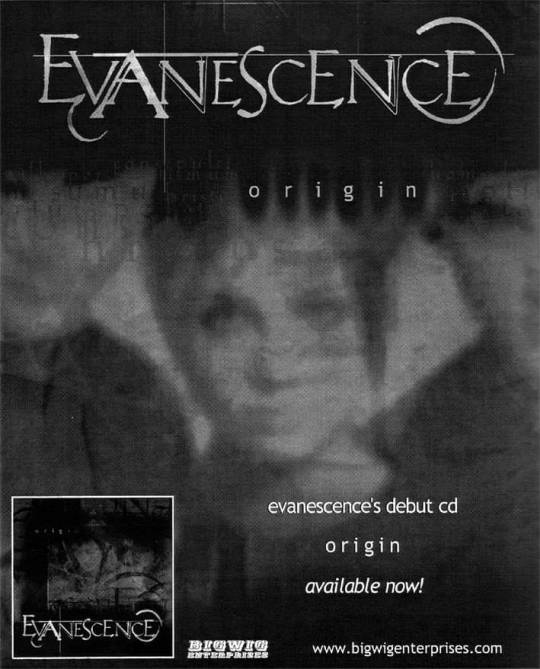
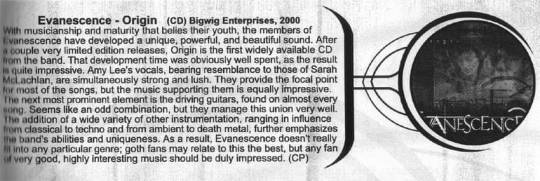
#evanescence#amy lee#ben moody#david hodges#nu metal#goth#2000s#2000s emo#early 2000s#mallgoth#symphonic metal#2000s nostalgia#origin#rare pics#rare#origin era#Bigwig Enterprises#debut era#debut cd#advertisement#original advertisement#extremely rare#super rare#bigwig enterprises#automata#automata 3.0#automata magazine#magazine ad#old magazines#2000
208 notes
·
View notes
Text
I realized what put me off so much about Enterprise.
When I watched TNG I was like "damn if I had only seen this as a kid I could have figured out my gender stuff way earlier."
If I had seen Enterprise as a kid I would have just been pushed even deeper into the cisgender closet.
#how the fuck this show followed tng ds9 and voy i just do not understand#the early 2000s were a horrible time of regression#star trek Enterprise#star trek tng
1 note
·
View note
Text
A thought on a queer Star Trek timeline
Watching Star Trek from the original series to modern times is to fast forward through the evolution of queer rights through the 20th and early 21st century.
In the original series queerness must be imagined in the close relationship between Kirk and Spock. We can only see ourselves in what we hope and dream about for the future. We get Amok Time.
In the 80's queer people start to materialize in the background. TNG takes tentative steps towards telling our stories, still cloaked in the allegory. We get Outcast.
In the 90's Ds9 gives us Rejoined. Still cloaked in allegory, but the lines get sharper, the mist starts to lift. A character has a monologue about how two people that love each other should be able to be together. Hidden winks has turned into words.
Voyager, while a good show in other respects, does not give us a single crumb of queerness. Aside from the relationships we ourselves imagine.
In the 2000's we are on the cusp of actually having queer people on screen. Enterprise tries to tell stories of gender (Cogenitor) and the AIDS crisis (Stigma), two episodes that are still filtered through a limited understanding of both. When Enterprise ends in 2005 and this Star Trek era ends with it, queer representation in film and tv is still scarce.
The AOS era instead is where queer people, for the first time, stepped out of subtext. Sulu is married to a man - a nod to George Takei, the original series actor. Star Trek Beyond comes out in 2016, the year after same sex marriage is legalized in the US.
It isn't until 2017 that a Star Trek show officially, without subtext or allegory, gets queer characters, when Paul Stamets and Hugh Culber are married on Discovery. Discovery also adds further queer characters down the line, finally saying that yes - queer humans do exist in the future.
I know you all will have opinions on what is queer or not. But when tracking the evolution of queer representation it's important to separate subtext from text and to separate when something is allegoric verses not.
I interpret Jadzia Dax as queer - but she is not human. She is an alien wrapped inside a gender non confirming shroud of gray areas. That is the strength of her character - that it allows the writers to explore themes that otherwise would have been taboo. But the fact that they could only pursue queer storylines with non human characters tells you something about the times.
it really feels like Star Trek was late to the party with queer representation. I think there's multiple reasons for that. One is that when Enterprise was created, it still carried the legacy of shows created in the 80's and 90's. Enterprise itself is also literally a prequel - there seemed to be little desire to be bold and innovative.
Timing is I think the main reason why Star Trek trailed behind. Between Enterprise ending in 2005 and Star Trek Discovery starting in 2017 there's a whole era of representation. If Enterprise had dared make an actual queer character, like Malcolm Reed, it would have been just ahead of the wave of representation that started popping up in the late 00's - but instead it closed on a similar note as DS9 did 10 years earlier.
Feel free to add your favorite queer episodes. There are some "official" queer episodes - but there's a bunch more that meant a lot for us as queer people, for one reason or another.
#Apparently I had a lot to say today#queer trek#Let Reed be gay 2024#I say 'a thought' like this isn't an essay
125 notes
·
View notes
Text

There are some mechs that have a broad range of capabilities and appeal, and then there's mechs like the Legionnaire. Originally convieved of by Corean enterprises as a bigger version of the Centurion, the design eventually morphed into something far different from the original medium speed, medium weight trooper mech. The Legionnaire is a one-gun medium cav mech- it rocks a 350 xl engine, targetting computer, and one giant fuckoff gun- usually a rotary autocannon. Sometimes it has a couple medium lasers, sometimes it loses the targetting computer to pack an Arrow launcher to be freakishly mobile artillery, but overwhelmingly it's a fast mech with a big gun and if you don't like it then the door's right there.


The mech's IRL history rings similar chords to it's fiction as a specialized and somewhat contentious design. The Legionnaire is a Mechwarrior: Dark Age design that really wears that influence on it's sleave. It's industrial, but in a sort of early 2000s Rob Liefeld way with lots of point, exposed munitions and big autocannons. Unlike a lot of MWDA mechs, the One Big Gun appearance of the Legionnaire saved it from a lot of the most terminal AC-itis that some of its fellows suffer from, slotting in next to the Blitzkrieg as a Davion alternative to Steiner's third and increasingly deranged attempt to salvage what they could from the Hollander project. I like the thing, but in a sort of olives and sharp bleu cheese way- it's an acquired taste and something I'm not always in the mood for, the appear of the machine isn't really too demented to be invisible to most mechwarriors.
#battletech#hobby#miniatures#mini painting#battlemech#mechwarrior#mecha#mech#medium mech#Legionnaire#house havion#federated suns
40 notes
·
View notes
Text
It gets better bro, I swear.
Y'all better be right about ent as a show and archer as a character getting better because currently this sucks
#star trek enterprise#star trek#Star Trek ent#star trek enterprise apologist#it's not a bad show#people just don't like the clear early-2000's approach it takes
4 notes
·
View notes
Text
Happy WIP Wednesday, everyone! @brynnmclean tagged me and I seized the opportunity to write over 2000 words of one of the very early sections of the femslash Spirk fic. This isn't all of it, but quite a bit:
"Captain," said S'paak, her nod precisely calibrated to the degrees of rank between them. "You requested my presence here?" At this, Captain Pike glanced up. She saw no sign of illness or particular perturbation on his face, nothing unusual at all. Peculiar. "Commander S'paak," he replied, and gestured at one of the chairs. "Don't worry, you're not here because of any error on your part. I wanted to discuss some information you should know." "I do not experience worry," she said automatically, settling into the chair opposite him as her thoughts hurried onward. "I presume this information relates to my forthcoming duties as first officer, once you have moved on to your next assignment?" The captain smiled, though she wasn't sure what about her conclusion would provoke humor. "A reasonable presumption as ever, Commander." Pike cleared his throat, sitting down in the chair nearest him. S'paak found herself unsettled by this. Her position typically resulted in her standing or sitting at his left hand, rather than across the table, which had never struck her as quite so large before. Nor had the briefing room previously seemed so small. She nearly frowned at the thought, fanciful and useless—but then, she'd never bothered estimating the dimensions until now. "Starfleet Command has chosen the next captain of the Enterprise," said Pike. "Finally. As the prospective first officer, you should have been notified already." "I was, sir, though I'm not familiar with Captain Kirk," S'paak admitted. "Did they inform you of the reason for such a long delay?" "Yes, surprisingly," he said. It was, indeed, unlike his superiors to explain themselves in any kind of substantive detail. S'paak waited. Captain Pike folded his hands in front of him, visibly uncomfortable despite his professional manner. She'd always admired him, but within the silent privacy of her own mind, she conceded that she did not consider his emotional transparency among his most estimable qualities. "No doubt you're aware that Jessica Kirk will be the first woman in Starfleet in full command of a major starship," said Pike. "It's always good to see us progress further towards our principles and ideals, of course, but I gather there was a certain ... inertia of tradition to overcome. The way things have always been done et cetera, even though she's unquestionably the best candidate. In any case, you've got your finger on the pulse of the crew. Do you think there will be any issues there?" "I don't place fingers on any pulses, captain," she said. "I have no particular medical expertise." His face gained a tinge of long-suffering patience that she perhaps enjoyed more than a Vulcan ought.
Without a change of expression, she continued, "That said, there may be some difficulties, yes. The crew is certainly too disciplined for undeserved insubordination, in my judgment, but the presence of anyone they're not accustomed to seeing in their command structure can provoke a certain amount of hostility and distrust without any logical rationale."
She knew she didn't need to offer the obvious evidence of her own experience, even if she'd never captained a starship and had no desire to do so. Pike grimaced slightly.
"True enough, unfortunately," he said, and glanced a little to the side at nothing she could see. S'paak thought it likely that he was avoiding her gaze; it was a habit of many humans when discussing the failings of their own kind, as if the disrespect directed at S'paak and others could be somehow lessened by not looking at them. Entirely illogical.
"Well," Pike added, "no doubt she'll earn their respect quickly enough."
S'paak raised an eyebrow. "May I have permission to speak freely, captain?"
"Of course."
His eyes had focused on her face once more, so she maintained even tighter control over her features than usual, and kept her hands very still. In a level voice, she asked,
"Was your career the price of this progress?"
Pike's eyes widened—not theatrically, but enough for her to understood that she had surprised him. Then he smiled again, though it didn't seem in amusement this time. Leaning back in his chair, Pike's entire posture relaxed in a way she had only observed around the senior officers.
"Not at all," he said easily. "I was getting moved up to fleet captain regardless, and this new voyage demands rather different strengths than mine."
S'paak doubted that. She'd never served under a commanding officer with more presence of mind, honesty, or unfaltering resolve. She could not bring herself to say that—at least not in those terms, which might easily sound sentimental, regardless of tone and the wealth of empirical evidence for her opinion.
"Does it?" she said.
Pike gave a crisp nod. "Yes. I'm sure you'll find it rewarding to discover and analyze new phenomena, but a five-year-long deep space mission into completely unknown and unexplored territories is likely to involve some very steep risks and personal danger for the captain."
"That's to be expected," she admitted. "You have faced those before, however. Sir."
"Not to this extent," said Pike. "At least, not recently, and certainly not for so long. It's ... let's say, entirely logical for Starfleet to search for a captain with more fortitude of mind and body than I have these days. They didn't want to sacrifice leadership ability or intelligence in their choice of commanding officer, yet this particular mission also calls for someone physically strong, resilient, dauntless. They're not wrong about that."
It was logical, yet she still did not altogether approve. But he laughed under his breath before she could register further dissent.
"Not that humans are any of those things by Vulcan standards," he said.
S'paak inclined her head, remembering herself as a child, accidentally leaving bruises on her mother's hands and arms and shoulders. She hadn't understood just how fragile Amanda was until Sarek explained the matter with the stark clarity that marked all of his explanations.
"Well, those criteria certainly narrowed down the list of possibilities, as you might imagine," he went on. "Kirk's a bit younger than they'd have preferred, so there was that to consider as well, but she's such a good fit that I gather the delay was really just dithering on their way to the inevitable."
"She did appear quite young in the photograph accompanying the personnel change," S'paak said. "It was small and of poor quality, however, so I couldn't be certain."
"She's only thirty-two or thirty-three," he replied. "She'll be the youngest starship captain in the fleet by years once she's given command. So I'm sure you can see why your role as first officer is likely to be particularly important in this transition, especially given your familiarity with the Enterprise and much of the crew and ... so on."
In general, S'paak found so on painfully imprecise, but his sudden awkwardness left little doubt about what he meant. She was a half-Vulcan woman as well as an experienced senior officer. On many occasions, others' reactions to her species and gender had proven inconvenient to the fulfillment of her responsibilities. Now, her years of navigating not only the science laboratories and bridge of the ship, but the petty, irrational, incessant prejudices of those on it, could only render her a more useful right hand to a young woman in the captain's seat, doing what no woman of any species had done before.
S'paak was not entirely sure what she thought of that. She simply nodded.
"If you've got any concerns or reservations," he said, "this would be a good time to air them."
She considered that, barely registering the cool, smooth texture of the table under her hands, or the mechanized air circulating through the room, or the dull simplicity of the briefing room's furnishings, or even Pike himself. S’paak had numerous points of … not curiosity, exactly, but inquiries that presented themselves to her mind. She would be first officer; she should inform herself well enough to be prepared.
"It seems to me," said S'paak slowly, "that an elevation so unprecedented, in so many ways, is improbable without some extraordinary cause or motive. Starfleet does not suffer such a dearth of qualified captains that no one else could have been found, had they wished to find someone else."
"True," he said, and just leaned back further, listening rather than interrupting her reasoning. She had always appreciated that about him.
"One obvious possibility is some form of ... I believe the usual term is nepotism," she said. "Her advancement might serve the interests of someone already in power, but the existence of a contact or relative with enough sway to ensure Captain Kirk's advancement to an unprecedented degree of authority is mere speculation without evidence. Such a person would likely not be unknown, yet I have no knowledge of any connection of the kind, and I doubt anyone alive has the influence to receive such a favor when it comes to a mission of this importance. Nor would a captain be chosen for this particular mission to be simply the face of progress."
"I agree," said Pike.
"Logic suggests the more probable explanation is some extraordinary quality or action of Captain Kirk's," she said. "It could easily be both, and easily consist of many traits and many successes. In fact, given the usual practices of Starfleet, anything else would be all but impossible."
Captain Pike straightened, his shoulders squaring even as his face returned to its usual friendly lines. "I can give you some peace of mind on that front."
"I do not lack peace of mind," she said flatly.
He ignored this. "She comes from a Starfleet family, sure enough—both parents, a brother—but none of them ever got as far as she has already. Respectable rather than influential. And you're right, nobody could pull strings hard enough to determine the choice of captain of the Enterprise. You don't need to worry about Kirk's qualifications. Yes, sorry, I know you don't experience worry. But believe me, the woman's got a line of commendations and awards as long as my arm and a sterling reputation."
"I see," said S'paak. "Sterling in what respect, captain?"
He waved his hand at nothing in particular. "From what I've heard, most respects. She's certainly no maverick, but tactically brilliant and creative when given command. A reliable and steady senior officer when she's not. We've had quite a few diplomatic resolutions credited to her involvement; by all accounts, she's quite charming and friendly. Brutal in a fight, though. Several of those commendations are for saving dozens of fellow crewmen on foot."
To S'paak, this paragon sounded both worthy of admiration and profoundly alarming as a commanding officer. Pike himself had commanded the Enterprise and its crew with a cool, consistent competence she found soothing. The impression of Captain Kirk forming in her mind was of someone altogether more unpredictable.
Nothing could be done about it now, she reminded herself. And S'paak had never been in a position to affect this outcome. What is, is.
"I see," she said. "There is no logical reason for reservations then, captain. I hope to be of use to Captain Kirk once the voyage commences."
"I have no doubts on that point," he said, springing up from his chair and striding over to the computer. Rather than giving it any instructions, however, he studied the machine for a moment and then glanced back at S'paak. "I'll be handing over the keys in a week, if all goes according to schedule. You're welcome to join Number One and me for the occasion."
S'paak blinked, intrigued as usual by the human capacity to produce multiple grammatically perfect sentences that bordered on incomprehensibility, with no appearance of effort. But the substance of the conversation was clearly over. She got to her feet and said,
"I would be honored, captain. Do you have any other matters to discuss?"
"No, I just wanted to get the temperature and pass on useful information," he said. Then he lifted one hand into the ta'al. "S'paak, you've been a hell of an officer. Live long and prosper."
She felt a distinct and improbable burning in her eyes, inner eyelid notwithstanding. S'paak raised her own hand.
"Live long and prosper, Captain Pike," she said.
-----
Like @brynnmclean, I'm tagging my own usual suspects: @kareenvorbarra, @heckofabecca, @steinbecks, @incognitajones, and anyone else who wants to!
#i had a blast with baby s'paak who is halfway through her evolution to deadpan troll and recognizing her emotions but not quiiiite#also one of the many delights of m->f genderbending is honestly platonic cross-gender relationships opening up everywhere#anghraine babbles#long post#fic talk#fic talk: the lesbian spock agenda#star peace#genderbending#s'paak#christopher pike#(not snw compliant and not trying to be. btw.)#jessica kirk#(not appearing in person but very much Present)#meme prattle#wip wednesday#gender blogging#c: who do i have to be#c: i object to intellect without discipline
33 notes
·
View notes
Text
Excerpt from this New York Times story:
Major science groups said Friday that they would publish work for the country’s flagship report on climate change, a project that the Trump administration threw into limbo by dismissing hundreds of scientists who had been working on it.
The American Geophysical Union and the American Meteorological Society said they would publish work originally meant for the assessment in their journals, should the authors choose to do so.
“It’s incumbent on us to ensure our communities, our neighbors, our children are all protected and prepared for the mounting risks of climate change,” Brandon Jones, the president of the union and a program director with the National Science Foundation, said in the statement. “This collaboration provides a critical pathway for a wide range of researchers to come together and provide the science needed to support the global enterprise pursuing solutions to climate change.”
The National Climate Assessment is a comprehensive review of the latest climate science that gauges how climate change is affecting the country and what can be done to adapt and mitigate its effects. There have been five published since 2000. The sixth edition was scheduled to be published in early 2028.
The new effort would not replace the federal report, which is Congressionally mandated, the statement from the American Geophysical Union and the American Meteorological Society said.
The White House did not immediately respond to a request for comment. When the authors of the National Climate Assessment, known as NCA6, were dismissed, the email they received said that “the scope of the report is currently being re-evaluated in accordance with the Global Change Research Act of 1990.” That legislation created the U.S. Global Change Research Program, where the administration cut staff and funds in April.
It is not clear whether the administration will proceed with the assessment in a revised form, try to circumvent Congress and cancel it entirely, or pursue another path.
“This effort cannot replace NCA6, which undergoes thorough public and governmental review,” said Jason West, an environmental scientist at the University of North Carolina who led the air quality chapter in the previous assessment. “Nonetheless, it gives author teams that had already begun working an opportunity to complete and publish their work.”
18 notes
·
View notes